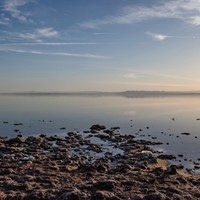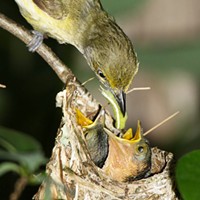Tuesday, October 27, 2009
MLPA Science Advisory Team Picked
Posted By Heidi Walters on Tue, Oct 27, 2009 at 10:43 AM
The scientists who will advise development of marine life protection areas on the North Coast of California have been appointed -- by outgoing Department of Fish and Game Director Donald Koch, who resigned last week and whose last day in office will be Nov. 1.
The science team includes several notables -- but not all of the vying notables, no doubt -- from around these parts: Eric Bjorkstedt, based in Trinidad with the National Marine Fisheries Service; HSU professor Dawn Goley with the Marine Mammal Education and Research Program; HSU Professor David Hankin with the Fisheries Biology Department; and Ron LeValley with Mad River Biologists.
There's a slew of others from along the pertinent stretch of coast. They'll have their first offical confab Oct. 30 in Eureka.
Here's the whole news release, issued this morning by Annie Reisewitz of the MLPA Initiative:
Marine Life Protection Act Science Advisory Team Members Announced for North Coast
California Department of Fish and Game Director Donald Koch announced today a panel of science advisors to assist in redesigning marine protected areas along the north California coast. The Marine Life Protection Act (MLPA) Master Plan Science Advisory Team (SAT) will provide scientific support for the MLPA Initiative.
"The scientists I have appointed to the advisory team are each uniquely qualified for this important task," Koch said. "Their experience and expertise in marine resources conservation make them well-suited to provide accurate, insightful advice and will help ensure that all decisions made in the coming months will be firmly rooted in the best available science."
The appointed members of the SAT include:
• Larry Allen, California State University Northridge, Department of Biology (Terminal Island)
• Eric Bjorkstedt, National Marine Fisheries Service (Trinidad)
• Mark Carr, University of California, Santa Cruz, Long Marine Lab (Santa Cruz)
• Chris Costello, Bren School of Environmental Science and Management (Santa Barbara)
• Kevin Fleming, California Department of Parks and Recreation, Natural Resources Division (Sacramento)
• Steve Gaines, Marine Science Institute (Santa Barbara)
• Dominic Gregorio, State Water Resources Control Board (Sacramento)
• Dawn Goley, Humboldt State University, Marine Mammal Education and Research Program (Arcata)
• David Hankin, Humboldt State University, Fisheries Biology Department (Arcata)
• John Largier, University of California, Davis, Bodega Marine Laboratory (Bodega Bay)
• Ron LeValley, Mad River Biologists (Eureka)
• Phillip Levin, Northwest Fisheries Science Center, National Oceanic and Atmospheric Association Fisheries (Seattle, Wash.)
• Steven Morgan, University of California, Davis, Bodega Marine Laboratory (Bodega Bay)
• Steven Murray, California State University Fullerton, College of Natural Sciences and Mathematics (Fullerton)
• Karina Nielsen, Sonoma State University, Department Of Biology (Rohnert Park)
• Peter Raimondi, University of California, Santa Cruz, Long Marine Lab (Santa Cruz)
• Steven Rumrill, South Slough National Estuarine Research Reserve (Charleston, Ore.)
• Astrid Scholz, Ecotrust, Jean Vollum Natural Capital Center (Portland, Ore.)
• Craig Strong, Crescent Coastal Research (Crescent City)
• Stephen Wertz, California Department of Fish and Game (Los Alamitos)
• Will White, University of California, Davis, Bodega Marine Laboratory (Bodega Bay)
Their first meeting will be on October 30 in Eureka. This will be a joint meeting of the North and South Coast SATs. More information and an agenda may be found at http://www.dfg.ca.gov/mlpa/meetings_n.asp.
The MLPA, enacted into law in 1999, directs the state to reexamine and redesign California's system of MPAs, which are discrete geographic marine or estuarine areas designed to protect or conserve marine life and habitat. The purpose of the act is to protect the state's marine life and habitats, marine ecosystems and marine natural heritage, as well as to improve recreational, educational and research opportunities provided by marine ecosystems.
A regional approach is being used to implement the MLPA along the state's coastline, with the current efforts focusing on the north coast from the California/Oregon border to Alder Creek near Point Arena in Mendocino County. Though the California Fish and Game Commission is the ultimate decision-making authority for implementing the MLPA, the extensive stakeholder-driven planning process will include a region-specific Blue Ribbon Task Force (BRTF), SAT and stakeholder group charged with providing information and recommendations to the Commission.
SAT members are charged with providing scientific advice to the regional stakeholder group regarding issues such as MPA placement, size and habitat considerations, and assist by reviewing draft documents and addressing scientific questions raised by the BRTF or the regional stakeholder group. The SAT members will also work closely with the stakeholder group to guide stakeholder development of draft MPA proposals.
The biologists, ecologists, oceanographers and economists who have been appointed to the North Coast SAT are scientists with specific expertise in marine life protection, the use of MPAs as a management tool, underwater ecosystems found in California waters, the biology and habitat requirements of major species groups in the state's waters, and water quality and related issues. Their expertise is specific to the north coast region.
The Commission will be asked to adopt MPAs in each study region along California's coast. Recommendations for the current north study region will be developed between now and late 2010, when the BRTF is expected to make a final recommendation on the north coast MPA proposals.
The first of the five study regions to be redesigned was the central coast; the California Fish and Game Commission adopted a final package of MPAs for this region in April 2007. The next study region to be redesigned was the north central coast, for which regulations were adopted on August 5, 2009. The south coast is nearing the end of the process as the north coast is just beginning. The San Francisco Bay will be the last region to be studied.
###
Speaking of...
Readers also liked…
more from the author
-
From the Journal Archives: When the Waters Rose in 1964
- Dec 26, 2019
-
Bigfoot Gets Real
- Feb 20, 2015
-
Danger at McCann
A kayaker's death has raised safety questions about low-water bridges
- Feb 19, 2015
- More »


































